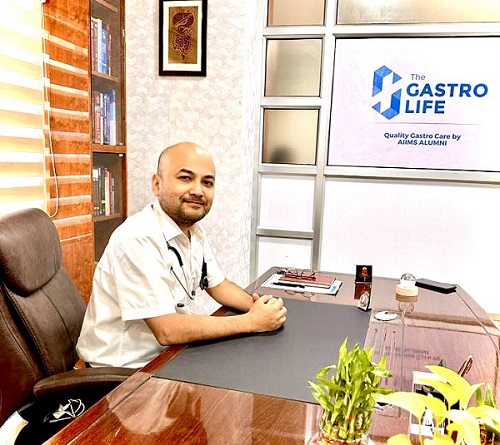Non-Alcoholic Fatty Liver Disease (NAFLD) is considered a modern-day epidemic that poses a significant health challenge in India and around the world.
Recently, a child accompanied by his parents visited my private clinic, which sparked my surprise since I typically see patients over the age of 12. Upon reviewing the child’s medical history, I discovered that he was overweight and had been experiencing stomach issues. A pediatrician had advised an abdominal ultrasound, which revealed fatty liver. Concerned, the parents promptly sought consultation with a gastroenterologist. This scenario has become increasingly common in medical practice, with physicians, gastroenterologists, and pediatricians frequently encountering patients with fatty liver disease.
NAFLD is characterized by the accumulation of more than 5% fat in the liver among individuals who do not have a history of heavy alcohol consumption. It encompasses various conditions, ranging from simple fatty liver to steatohepatitis, liver fibrosis, and advanced stages such as cirrhosis. In India, NAFLD has emerged as a major public health issue, contributing significantly to hepatic and extrahepatic diseases.
Two types of NAFLD exist:
- Isolated fatty liver, which is a milder form, and nonalcoholic steatohepatitis (NASH), a more destructive form. Isolated fatty liver involves fat accumulation in the liver without significant inflammation or damage to liver cells. This condition typically does not progress to advanced liver damage or cirrhosis.
- On the other hand, NASH often leads to severe liver conditions such as cirrhosis and is responsible for most fatal liver complications. While individuals generally develop one type of NAFLD, it is possible for those with the milder form to progress to the more critical form over time.
Globally, NAFLD affects approximately 25.2% of the adult population. Initially perceived as a disease predominantly seen in industrialized Western countries, NAFLD is increasingly prevalent in low- and middle-income developing nations. South America and the Middle East report the highest rates of NAFLD, while Africa reports the lowest. Asia, including India, has a prevalence of 29.6%, which is considerably significant compared to the West. Lifestyle changes and dietary patterns have had a profound impact on the rise of non-communicable diseases, including NAFLD, in developing countries. The prevalence of NAFLD in Asia has significantly increased over time.

A recent systematic review and meta-analysis conducted by the All India Institute of Medical Sciences, New Delhi, revealed that approximately one in three adults or children in India has NAFLD. Contrary to popular belief, NAFLD has also become prevalent in rural areas, affecting both urban and rural populations. Studies have indicated that the occurrence of this epidemic is not significantly influenced by the place of residence.
Most individuals with NAFLD do not exhibit specific symptoms or signs. The condition is often diagnosed during routine health check-ups or incidentally discovered during evaluations for other health issues. Some people may experience fatigue, pain, or discomfort in the upper right part of the abdomen. Interestingly, further evaluation frequently reveals the presence of diabetes or other chronic conditions in individuals diagnosed with NAFLD.
Some of the signs and symptoms of advanced scarring of liver (cirrhosis) include:
- Abdominal swelling (ascites)
- Enlarged blood vessels just beneath the skin’s surface
- Bleeding from the mouth or passage of black stool.
- Yellowish discoloration of the skin and eyes (jaundice)
Numerous diseases and conditions also increase the risk of NAFLD, including high cholesterol or triglyceride levels, hypertension, obesity (especially when abdominal fat is concentrated), polycystic ovary syndrome, sleep apnea, type 2 diabetes, underactive thyroid (hypothyroidism), and underactive pituitary gland (hypopituitarism).
A joint position paper published by the Indian National Association for the Study of the Liver, the Endocrine Society of India, the Indian College of Cardiology, and the Indian Society of Gastroenterology in March 2015 highlights the close association between NAFLD and metabolic syndrome. The prevalence of metabolic risk factors, such as diabetes mellitus and obesity, is rapidly increasing in India, placing the population at risk for NAFLD. Furthermore, individuals with NAFLD face an increased risk of developing cardiovascular ailments and diabetes mellitus over the long term.

The Indian National Association for Study of the Liver (INASL) published a guidance paper in December 2022 on the nomenclature, diagnosis, and treatment of NAFLD. It emphasizes that NAFLD is a major cause of chronic liver disease in India and globally. Given the high burden of NAFLD in India and the concurrent epidemics of obesity and type 2 diabetes mellitus, it is crucial to identify individuals at risk of progressive liver disease, streamline referrals, and guide appropriate management. Existing international guidelines on NAFLD often fail to encompass the entire landscape of NAFLD in India due to fundamental socio-cultural differences and variations in available healthcare infrastructure.
Maintaining an ideal body weight and BMI is a key step in preventing and managing NAFLD. Regular physical activities such as brisk walking, cycling, and resistance or flexibility exercises have become essential for controlling NAFLD. Overweight and obese individuals are at a higher risk of developing NAFLD and should prioritize exercise. Those who are overweight or obese should reduce their daily calorie intake and engage in increased physical activity. To lower the risk of NAFLD, it is recommended to follow a healthy plant-based diet rich in fruits, vegetables, whole grains, and healthy fats. Individuals with a healthy weight should strive to maintain it through a balanced diet and regular exercise at least five days a week. Consulting with dieticians can provide valuable guidance on maintaining a balanced diet.
Parents should also be vigilant about their children’s diets, teaching them to avoid excessive consumption of junk food and sugary beverages while encouraging regular physical activity. Although there are few drugs available for treating NAFLD, individuals who do not achieve weight loss through diet and exercise, particularly those with severe obesity, may require bariatric surgery. Treatment of associated conditions such as diabetes, hypertension, and high cholesterol is equally important in managing NAFLD.
India, with its large population, currently faces a critical situation, experiencing a high number of diabetes mellitus cases alongside a steady rise in the prevalence of metabolic syndrome, obesity, and dyslipidemia. The increasing population of NAFLD patients will further burden the healthcare infrastructure of our country. Recent reports indicate an alarming trend of NAFLD in rural India, affecting even non-obese and undernourished individuals. Alongside the rising number of NAFLD cases, liver-related mortality is also expected to increase in the near future. This issue cannot be solved solely by physicians and healthcare providers at the individual level. A national policy and strong participation from all sections of society, including policymakers, are needed. The inclusion of NAFLD in the National Program on Prevention and Control of Cancer, Diabetes, Cardiovascular Disease, and Stroke by the Ministry of Health and Family Welfare of India is a positive step towards addressing this issue.
Public awareness will also play a vital role in controlling NAFLD. It is crucial for every citizen, especially the younger generation, to be aware of the consequences of NAFLD and the importance of maintaining a healthy lifestyle.
Dr. B J Baruah MD.DM (AIIMS, New Delhi)
Gastroenterologist and Hepatologist
The Gastrolife, Guwahati


 Entertainment3 years ago
Entertainment3 years ago
 Education2 years ago
Education2 years ago
 Business2 years ago
Business2 years ago
 Technology2 years ago
Technology2 years ago






